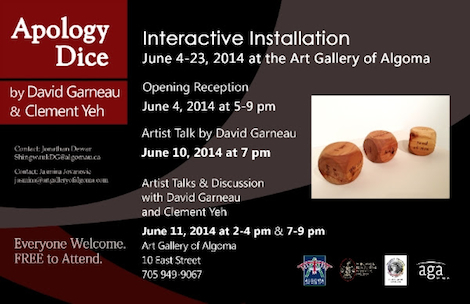
JOINT NEWS RELEASE
ALGOMA UNIVERSITY
ART GALLERY OF ALGOMA
**************************
Interactive installation June 4-23 with special programming June 10 and 11 at the Art Gallery
As part of the Shingwauk Residential Schools Centre (SRSC)'s ongoing critical and creative Healing and Reconciliation through Education programming and its partnership with the Art Gallery of Algoma (AGA), the SRSC and the AGA are pleased to announce a new, original, interactive installation by visiting artists David Garneau and Clement Yeh.
An opening reception will be held the evening of June 4, 5-9 p.m. at the AGA.
The installation will overlap and coincide with June 11, the anniversary of Prime Minister Stephen Harper's historic but apocryphal 2008 Statement of Apology to former students of Indian Residential Schools.
As Métis artist, curator, and educator David Garneau says: "Apology Dice is an artistic effort to stir emotional response, to help participants discover and express their feelings about this important issue. For ambivalent participants, rolling the dice may prompt more certainty. To those feeling more decided, play may reinforce their beliefs or perhaps unsettle them a little. Apology Dice is a conversation starter."
Garneau's collaborator, artist and self-styled maker of things Clement Yeh adds: "For many years I have wanted to make something that expresses my desire to be an ally with Indigenous peoples, but I didn't know how. The problems are so complex. Collaborating with David has given me a special opportunity to add my skills and empathy to this conversation, hopefully without being another intruder. Apology Dice is meant to stimulate conversation between people of different backgrounds, because only as a unified nation are we going to fix the problems within our country and within ourselves."
Garneau and Yeh will also be visiting artists at Algoma University and the AGA June 7-13, with both artists set to meet with students, faculty, and Residential School Survivors and families, as well as the larger community, and to activate the installation and animate conversation.
The AGA will host an artist talk by Garneau the evening of June 10 (7 p.m.) and both Garneau and Yeh will be in attendance June 11, 2-4 p.m. and 7-9 p.m. for artist talks and discussion.
Everyone is welcome.
Jonathan Dewar, SRSC director, says: "We are thrilled to welcome David Garneau back to Sault Ste. Marie. David has been an engaged and thoughtful supporter of our efforts at Algoma University for the past two years. We are similarly thrilled to welcome Clement Yeh for the first time. This piece is both simple and profound and its interactive nature, combined with the artists' generosity and fearlessness in literally putting themselves into this work by virtue of the activations they will lead on June 11, is to be commended."
For more information, please visit www.shingwauk.org or contact Jonathan Dewar, director, or Krista McCracken, research and curator at 705-949-2301 x 4623 or the Art Gallery of Algoma at www.artgalleryofalgoma.com or by calling 705-949-9067.
Biographies
David Garneau (Métis) is Associate Professor of Visual Arts at the University of Regina.
He is a painter of road kill and drive-by landscapes, Métis themes, maps, comics, and quilts.
Garneau is also a curator and writer most interested in the collision of nature and culture, metaphysics and materialism, and in contemporary Indigenous identities.
He has curated large group, two-person, and solo exhibitions, and written numerous catalogues, including essays on Lyndal Osborn; Peter von Tiesenhausen; Tanya Harnett; Michael Campbell; Linda Duvall; David Hoffos; Eric Cameron and Chris Gardiner.
He has recently given talks in Melbourne, Adelaide, New York, San Diego, Sacramento, and keynote lectures in Sydney, Toronto, Edmonton, Saskatoon, and Sault Ste Marie.
Garneau is currently working on curatorial and writing projects featuring contemporary Indigenous art and curatorial exchanges between Canada and Australia.
He is also part of a five-year, SSHRC-funded curatorial research project, Creative Conciliation, which is concerned with contemporary Indigenous and non-Indigenous art after the Truth and Reconciliation Commission, with Jonathan Dewar and the Shingwauk Residential Schools Centre among other partners.
Clement Yeh holds a BFA in Drawing from the Alberta College of Art and Design and an MFA in Sculpture from Concordia University.
His interests range widely across beauty, social injustice, environmentalism, craft, feminism, human rights, design, eroticism, pop culture, science fiction/fantasy, and whatever else catches his fancy.
He finds daily inspiration everywhere around him, and always seeks to make contemporary visual art accessible to the general public.
Despite the many hurdles and instability often associated with the artist's vocation, Clement makes art because that is the only path that he could ever be happy pursuing.
Knowing this compels him to passionately support his current art community as well as the next generation of artists whenever he can.
Complementing his personal studio practice is Makerbros.com, his Montreal-based custom prop/sculpture company in partnership with sculptor Ian Langohr, which offers him an alternate source of income, a place to continually hone his technical skills, and another platform from which to share his work with new audiences.
He is looking forward to working on more collaborative projects, such as Apology Dice, that explore the conversation around social inequalities in Canada.
About the Shingwauk Residential Schools Centre
The Shingwauk Residential Schools Centre is a cross-cultural research and educational development project of Algoma University, the Children of Shingwauk Alumni Association, and the National Residential School Survivor Society.
Shortly after the closure in 1970 of the Shingwauk Indian Residential School, and in the early years of Algoma University College's relocation to the present site, Residential School Survivors connected to the Shingwauk School, their families and communities, and their allies were catalysts in the growing Healing Movement, culminating in the introduction of the original Shingwauk Project in 1979 and the 1981 Shingwauk Reunion.
From these watershed events began the decades-long work of collecting, organizing and displaying photographs and other Residential School materials, conducting research, and educating the public that led to the establishment of the Children of Shingwauk Alumni Association and the Shingwauk Project, now known as the Shingwauk Residential Schools Centre, respectively.
**************************